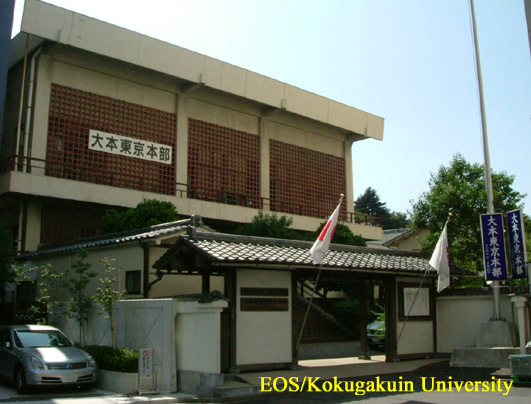- トップ
- Encyclopedia of Shinto
- Ōmoto
Encyclopedia of Shinto
| Main Menu: | |
| Links: |
詳細表示 (Complete Article)
| カテゴリー1: | 8. Schools, Groups, and Personalities |
|---|---|
| カテゴリー2: | Modern Sectarian Groups |
| Title | Ōmoto |
| Text | A Shinto-derived new religion started by Deguchi Nao (1836-1918), considered its kaiso (original founder), and Deguchi Onisaburō (1871-1948), its seishi (spiritual teacher). Deguchi Nao, who was from Ayabe in Kyoto Prefecture, had a "spirit dream" at the lunar New Year in 1892, and thereafter became possessed (kamigakari) by a spirit that began to speak through her under the name Ushitora no Konjin. Subsequently she began to record the deity's words in automatic writing. Due to her reputation for prophecies and faith healing her followers grew in number, and for a time from 1895 onwards she carried out proselytizing activities in conjunction with the religious movement Konkōkyō. However, in 1898 she met Ueda Kisaburō (the later Deguchi Onisaburō). Kisaburō had studied Honda Chikaatsu's "Spirit Studies" (Honda Reigaku) and method of mediated spirit possession (chinkon kishin) from Honda's disciple Nagasawa Katsutate in Shizuoka and, after acting as mediator (saniwa) for Nao, he judged Nao's possession experience to be genuine. Thereafter the two continued their collaboration, despite a variety of disagreements and conflicts. In 1899 they established the Kinmeikai which changed its name to the Kinmei Reigakkai later in the same year. In 1900 Kisaburō married Nao's fifth daughter Sumi and changed his name to Deguchi Onisaburō. The system of Ōmoto was thus established with these two founders, based on Nao's automatic writings (ofudesaki) and Onisaburō's spirit studies and techniques. In 1908 they established the group Dai Nihon Shūseikai and began serious proselytizing work. In 1913 the movement changed its name to Taihonkyō, and then again in 1916 to Kōdō Ōmoto. After Asano Wasaburō, (a teacher at Japan's Naval College) joined the group in 1916 and began to conduct proselytizing activities on its behalf, various intellectuals and high-ranking military officials began to join its ranks. The group became more active in promoting Nao and Onisaburo's automatic writings and spiritual techniques, and together with the purchase of a daily newspaper, the Taishō nichinichi shinbun in 1920, the group's activities in and outside Japan came to be seen as a major social issue. Within a political climate in which the authorities were inclined towards making precautionary interventions, this led to the "first Ōmoto incident" (Ōmoto jiken) in 1921. Afterwards, the movement undertook various reforms, including changing its name from Kōdō Ōmoto ("great origin of the imperial way") to merely Ōmoto ("great origin"), but its political activities, such as the formation of the Shōwa Seinenkai in 1929 and the Shōwa Shinseikai in 1934 caused concern to the authorities, leading to their intervention in the "Second Ōmoto Incident" of 1935. At that time, Ōmoto's headquarters were razed to the ground, its entire organization disbanded and its leading members taken into custody. Following the end of World War II, the organization was revived as the Aizen'en, a movement dedicated to the goal of world peace, and in 1946 it was registered as such under the Religious Corporations Ordinance. In 1952, it registered under the Religious Corporations Law as the religious corporation Ōmoto. Its strength greatly diminished as a result of its two prewar experiences of repression, but in the post-war era it has focused especially on peace activities and recently has again begun emphasizing "spirit studies." Headquarters: Kyoto Prefecture Nominal membership: approximately 170,000. See also Deguchi Nao, Deguchi Onisaburō. - Tsushiro Hirofumi |





